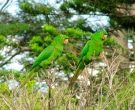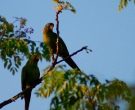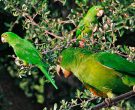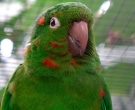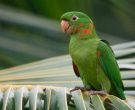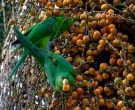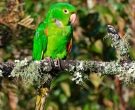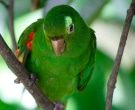Content |
|---|
Description:
Of 32 cm. length and a weight between 140 and 170 g..
The White-eyed Parakeet (Psittacara leucophthalmus) has the head dark green with small scattered red feathers, especially in the area of the lores, cheeks, sides neck and throat. The head and nape Some birds are almost entirely green, others have solid red spots in the cheeks, with numerous scattered red feathers elsewhere.
The upperparts are dark green, with one or two scattered red feathers. Upper, the wings dark green, with a little red in the curve; undertail, with golden brown flight feathers, the outer red and green small coverts inner; Yellow large coverts external and green internal.
The underparts Green with scattered red feathers on the throat and the chest, sometimes forming irregular patches. Upper, the tail dark green; Brown down.
The bill hooked is color Horn and its gray tip; bare periophthalmic grayish white; irises yellow-orange; legs grey.
The plumage of the male and the female, they are identical.
The immature they have more muted colors; some feathers Red in the head, No red in the bend of wing and olive in the underwing-coverts outermost.
- Sound of the White-eyed Parakeet.
Subspecies description:
-
Psittacara leucophthalmus callogenys
(Salvadori, 1891) – They have head, neck and throat, green grass dark with small feathers red color above the cheeks. The the mantle, the wing-coverts, the tail and primary feathers of the tail are dark green. The lower part of the chest and flanks of the body are green clear. The feathers largest of the wings and secondaries are dark green with a grey reflection at the ends. Smaller feathers of the wings and the area of the wing curvature are bright red; small coverts feathers are red; the feathers of the greater coverts are yellow. The top of the large feathers of the tail are dark green, the underparts is olive green.
The eyes are black with the irises orange-brown. The bare periophthalmic is grayish white. Bill color horn, the sides and the tip of the upper part are dark gray. Legs brownish grey, black nails.
On average largest the species nominal with the bill more robust. Birds in the West have a green dark.
-
Psittacara leucophthalmus leucophthalmus
(Statius Müller, 1776) – The species nominal.
-
Psittacara leucophthalmus nicefori
(Meyer de Schauensee, 1946) – Similar to the species nominal, except for having a red frontal band.
Habitat:
Video – "White-eyed Parakeet" (Psittacara leucophthalmus) |
|---|
The White-eyed Parakeet It is in a great range of forest habitats and forests, mainly in lowlands, even if they manage to reach altitudes of 1.700 meters in the Ecuador and 2.500 meters in Bolivia.
In the Amazon, they are in tropical rainforests, mostly along the rivers (including the forests and marshes), in scattered areas of woodland and in land grown in wetlands, mangroves, sheets and the forests of Palms in the Guianas, chaco types of forests in the South of its range, gallery forests and alluvial forests in Bolivia.
The White-eyed Parakeet they are highly gregarious, they form flocks, usually, hundreds of birds (usually up to 90), covering large expanses between the roosts and feeding areas.
In the Amazon, in general, birds travel along the banks of rivers, crossing also large tracts of forest to reach the meanders and hidden Marsh.
They form large community groups to sleep in trees, sugar cane fields and caves.
Associated with the Blue-crowned Conure (Psittacara acuticaudatus), the Blue-headed Parrot (Pionus menstruus), the Chestnut-fronted Macaw (Ara severus) and
Crimson-bellied Parakeet (Pyrrhura perlata), in mixed flocks, especially while they forage.
Reproduction:
The nest It consists of a natural cavity in a tree, often a palma, but also in limestone caves in Mato Grosso, Brazil. The female usually deposits there 3 white eggs, What incubates alone during 24 or 25 days. During this time, It is fed by the male. At birth the chicks are completely naked, a gray marker appears at the end of the first week. Son fed by parents for approximately 6 weeks, those that leave the nest and get together with the family group. are still dependent parents during 2 to 3 months.
The breeding season It has been reported in the months of November-December, in Argentina; July-August, in the East of Peru; From January to April, Mato Grosso; in Guianas during the month of February.
Food:
The diet of this species depends on the habitat, including a variety of dried fruits, seeds, fruit, berries, flowers and insects.
In general, they feed in the canopy, Although also feed on of grass seeds. Other reported foods include fruits of Palms and Goupia glabra, Tetragastris altissima and Allantoma lineata, as well as flowers Erythrina and ficus.
Distribution:
Size of its range (reproduction / resident): 13200000 km2
The White-eyed Parakeet are widespread in much of the North of South America, to the East of the Andes, to the North of Argentina.
Are distributed from the West of the Guianas (absent from Guyana), through Venezuela, from Anzoátegui and Monagas through the Delta Amacuro, until Bolívar and amazon, and up to the Colombian Amazon, to the North of the Department of the Goal. They live in much of Ecuador and Peru.
Extend through the entire interior of Brazil and possibly reach the coast of São Paulo and Rio Grande do Sul (absent in the arid zones of the Northeast, mountainous areas of the northern basin of the amazon in Brazil and Venezuela, and the basin of the Black river in Brazil and Colombia).
Are also distributed to the East of Bolivia through Paraguay until Argentina, to the South of Santa Fe and Between rivers (possibly in the North of Buenos Aires), including Tucumán and Catamarca (There are no recent reports in Catamarca or Santa Fe, While reports of Santiago del Estero, Córdoba and San Luis they are probably incorrect).
- Narosky and Di Giacomo (1993) they consider that the population in the city of Buenos Aires and its surroundings possibly originated from specimens escaped from captivity, i.e. released or escaped pet, owners or traffickers of fauna.
Observed in the highest parts of Uruguay.
In general resident, Although some seasonal movements seem to occur in some areas. The most numerous in the center of the range, the least, at the edges. Locally abundant in the Amazon central and Mato Grosso, Brazil, as well as in the east of Peru. common in Colombia. Quite common in the forests of the coast of Suriname and in the gallery forests of Santa Cruz in Bolivia. Unevenly distributed in the North of Bolivia, where it is described as common to rare. common in Argentina, especially in the North.
The Aratinga Ojiblanca It adapts easily to the degradation and urban areas, long as no sources of food and nesting places (ceilings and other cavities) and this occurs in several cities.
Large captive population with high volume of international trade, in particular from Argentina, where the species, Perhaps, is being threatened due to the capture.
Subspecies distribution:
-
Psittacara leucophthalmus callogenys
(Salvadori, 1891) – It is from Ecuador, Northeast of Peru and Northwest of Brazil.
-
Psittacara leucophthalmus leucophthalmus
(Statius Müller, 1776) – The species nominal.
-
Psittacara leucophthalmus nicefori
(Meyer de Schauensee, 1946) – Its validity is based on a single specimen found in an area around Guaicaramo in the guavio river, Department of the Goal, Colombia.
Conservation:
• Red List category of the UICN current: Least concern
• Population trend: Decreasing
The size of the world population White-eyed Parakeet It has not been quantified, but this species is described as “common” (Stotz et to the., 1996).
The species has undergone intense trade: from 1981, When it was included in the Appendix II, 60.207 individuals have been captured in the wild, registered for the international trade (UNEP-WCMC trade database CITES, January 2005).
"White-eyed Parakeet" in captivity:
The White-eyed Parakeet they are among the best talkers within the family Aratinga. Well socialized they can become a good companions. Rarely are destructive and usually they are not pijas, they often take the choice to imitate human speech in place. Personality always varies from bird to bird, but they are generally known to be very playful and curious.
Imported birds are, mostly, shy and take time to gain confidence with their caregiver.
Alternative names:
– White-eyed Parakeet, White-eyed Conure, Green Conure, White eyed Parakeet (English).
– Conure pavouane, Perriche pavouane, Perruche pavouane (French).
– Pavuasittich (German).
– Aratinga-de-bando, araguaí, araguari, aratinga, arauá-i, aruaí, guira-juba, maracanã, maracanã-malhada, maricatã, periquitão-maracanã (Portuguese).
– Aratinga Ojiblanca, Calacante ala roja, Calancate Ala Roja, Loro Barranquero, Loro de ala roja, Loro Maracaná, Maracaná ala roja, Perico Ojiblanco, Periquito Verde (español).
– Calacante ala roja, Calancate Ala Roja, Loro de ala roja (Argentina).
– Loro ojiblanco, Perico Ojiblanco (Colombia).
– Cotorra de Ojo Blanco (Peru).
– Maracaná ala roja (Paraguay).
– Loro Barranquero, Loro Maracaná (Uruguay).
– Perico Ojo Blanco (Venezuela).
scientific classification:
– Order: Psittaciformes
– Family: Psittacidae
– Genus: Psittacara
– Scientific name: Psittacara leucophthalmus
– Citation: (Statius Müller, 1776)
– Protonimo: Psittacus leucophthalmus
White-eyed Parakeet images:
Sources:
Avibase
Parrots of the World – Forshaw Joseph M
Parrots A Guide to the Parrots of the World – Tony Juniper & Mike Parr
Birdlife
Photos:
(1) – White-eyed Parakeet (also known as the White-eyed Conure) in Piraju, Sao Paulo, Brazil By Dario Sanches [CC BY-SA 2.0], via Wikimedia Commons
(2) – White-eyed Parakeet at the aviary at the Mayaguez Zoo in Mayaguez, Puerto Rico By Kati Fleming (Own work) [CC BY-SA 3.0], via Wikimedia Commons
(3) – A White-eyed Parakeet in Reserva Guainumbi, Sao Luis do Paraitinga, Sao Paulo, Brazil By Dario Sanches from Sao Paulo, Brazil [CC BY-SA 2.0], via Wikimedia Commons
(4) – Barao do Rio Branco square, Serra Negra-SP By Dario Sanches [CC BY-SA 2.0], via Wikimedia Commons
(5) – White-eyed Parakeet (also known as White-eyed Conure) in Goiania, Goiás, Brazil By Wagner Machado Carlos Lemes [CC BY 2.0], via Wikimedia Commons
(6) – White-eyed Conure (Aratinga leucophthalmus) – upper body, neck and face. In captivity in the Parrot’s Garden (Jardim dos Louros), in the Botanical Garden of Funchal, Madeira island, Portugal By jmaximo [CC BY 2.0], via Wikimedia Commons
(7) – White-eyed From The Crossley ID Guide Eastern Birds By Richard Crossley (Richard Crossley) [CC BY-SA 3.0], via Wikimedia Commons
(8) – White-eyed Conure, also called White-eyed Parakeet, in Brazil By Dario Sanches [CC BY-SA 2.0], via Wikimedia Commons
(9) – Couple of white-eyed parakeets (Aratinga elucophthalma). Spotted in Sao Carlos, Brazil By Leoadec (Own work) [CC BY-SA 3.0 or GFDL], via Wikimedia Commons
Sounds: (Xeno-canto)


